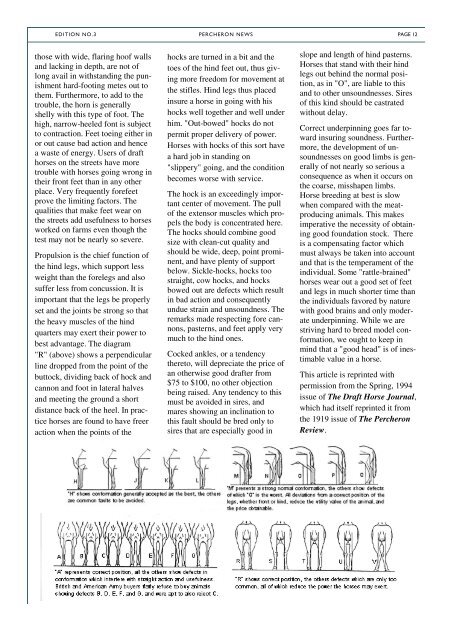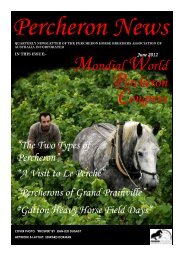to view the newsletter - Percheron Horse Breeders Association of ...
to view the newsletter - Percheron Horse Breeders Association of ...
to view the newsletter - Percheron Horse Breeders Association of ...
Create successful ePaper yourself
Turn your PDF publications into a flip-book with our unique Google optimized e-Paper software.
EDITION NO.3<br />
those with wide, flaring ho<strong>of</strong> walls<br />
and lacking in depth, are not <strong>of</strong><br />
long avail in withstanding <strong>the</strong> punishment<br />
hard-footing metes out <strong>to</strong><br />
<strong>the</strong>m. Fur<strong>the</strong>rmore, <strong>to</strong> add <strong>to</strong> <strong>the</strong><br />
trouble, <strong>the</strong> horn is generally<br />
shelly with this type <strong>of</strong> foot. The<br />
high, narrow-heeled font is subject<br />
<strong>to</strong> contraction. Feet <strong>to</strong>eing ei<strong>the</strong>r in<br />
or out cause bad action and hence<br />
a waste <strong>of</strong> energy. Users <strong>of</strong> draft<br />
horses on <strong>the</strong> streets have more<br />
trouble with horses going wrong in<br />
<strong>the</strong>ir front feet than in any o<strong>the</strong>r<br />
place. Very frequently forefeet<br />
prove <strong>the</strong> limiting fac<strong>to</strong>rs. The<br />
qualities that make feet wear on<br />
<strong>the</strong> streets add usefulness <strong>to</strong> horses<br />
worked on farms even though <strong>the</strong><br />
test may not be nearly so severe.<br />
Propulsion is <strong>the</strong> chief function <strong>of</strong><br />
<strong>the</strong> hind legs, which support less<br />
weight than <strong>the</strong> forelegs and also<br />
suffer less from concussion. It is<br />
important that <strong>the</strong> legs be properly<br />
set and <strong>the</strong> joints be strong so that<br />
<strong>the</strong> heavy muscles <strong>of</strong> <strong>the</strong> hind<br />
quarters may exert <strong>the</strong>ir power <strong>to</strong><br />
best advantage. The diagram<br />
"R" (above) shows a perpendicular<br />
line dropped from <strong>the</strong> point <strong>of</strong> <strong>the</strong><br />
but<strong>to</strong>ck, dividing back <strong>of</strong> hock and<br />
cannon and foot in lateral halves<br />
and meeting <strong>the</strong> ground a short<br />
distance back <strong>of</strong> <strong>the</strong> heel. In practice<br />
horses are found <strong>to</strong> have freer<br />
action when <strong>the</strong> points <strong>of</strong> <strong>the</strong><br />
PERCHERON NEWS<br />
hocks are turned in a bit and <strong>the</strong><br />
<strong>to</strong>es <strong>of</strong> <strong>the</strong> hind feet out, thus giving<br />
more freedom for movement at<br />
<strong>the</strong> stifles. Hind legs thus placed<br />
insure a horse in going with his<br />
hocks well <strong>to</strong>ge<strong>the</strong>r and well under<br />
him. "Out-bowed" hocks do not<br />
permit proper delivery <strong>of</strong> power.<br />
<strong>Horse</strong>s with hocks <strong>of</strong> this sort have<br />
a hard job in standing on<br />
"slippery" going, and <strong>the</strong> condition<br />
becomes worse with service.<br />
The hock is an exceedingly important<br />
center <strong>of</strong> movement. The pull<br />
<strong>of</strong> <strong>the</strong> extensor muscles which propels<br />
<strong>the</strong> body is concentrated here.<br />
The hocks should combine good<br />
size with clean-cut quality and<br />
should be wide, deep, point prominent,<br />
and have plenty <strong>of</strong> support<br />
below. Sickle-hocks, hocks <strong>to</strong>o<br />
straight, cow hocks, and hocks<br />
bowed out are defects which result<br />
in bad action and consequently<br />
undue strain and unsoundness. The<br />
remarks made respecting fore cannons,<br />
pasterns, and feet apply very<br />
much <strong>to</strong> <strong>the</strong> hind ones.<br />
Cocked ankles, or a tendency<br />
<strong>the</strong>re<strong>to</strong>, will depreciate <strong>the</strong> price <strong>of</strong><br />
an o<strong>the</strong>rwise good drafter from<br />
$75 <strong>to</strong> $100, no o<strong>the</strong>r objection<br />
being raised. Any tendency <strong>to</strong> this<br />
must be avoided in sires, and<br />
mares showing an inclination <strong>to</strong><br />
this fault should be bred only <strong>to</strong><br />
sires that are especially good in<br />
PAGE 12<br />
slope and length <strong>of</strong> hind pasterns.<br />
<strong>Horse</strong>s that stand with <strong>the</strong>ir hind<br />
legs out behind <strong>the</strong> normal position,<br />
as in "O", are liable <strong>to</strong> this<br />
and <strong>to</strong> o<strong>the</strong>r unsoundnesses. Sires<br />
<strong>of</strong> this kind should be castrated<br />
without delay.<br />
Correct underpinning goes far <strong>to</strong>ward<br />
insuring soundness. Fur<strong>the</strong>rmore,<br />
<strong>the</strong> development <strong>of</strong> unsoundnesses<br />
on good limbs is generally<br />
<strong>of</strong> not nearly so serious a<br />
consequence as when it occurs on<br />
<strong>the</strong> coarse, misshapen limbs.<br />
<strong>Horse</strong> breeding at best is slow<br />
when compared with <strong>the</strong> meatproducing<br />
animals. This makes<br />
imperative <strong>the</strong> necessity <strong>of</strong> obtaining<br />
good foundation s<strong>to</strong>ck. There<br />
is a compensating fac<strong>to</strong>r which<br />
must always be taken in<strong>to</strong> account<br />
and that is <strong>the</strong> temperament <strong>of</strong> <strong>the</strong><br />
individual. Some "rattle-brained"<br />
horses wear out a good set <strong>of</strong> feet<br />
and legs in much shorter time than<br />
<strong>the</strong> individuals favored by nature<br />
with good brains and only moderate<br />
underpinning. While we are<br />
striving hard <strong>to</strong> breed model conformation,<br />
we ought <strong>to</strong> keep in<br />
mind that a "good head" is <strong>of</strong> inestimable<br />
value in a horse.<br />
This article is reprinted with<br />
permission from <strong>the</strong> Spring, 1994<br />
issue <strong>of</strong> The Draft <strong>Horse</strong> Journal,<br />
which had itself reprinted it from<br />
<strong>the</strong> 1919 issue <strong>of</strong> The <strong>Percheron</strong><br />
Re<strong>view</strong>.



